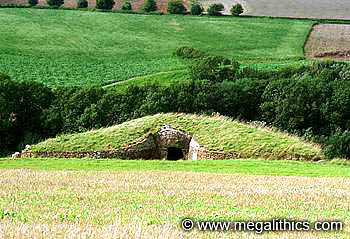
 |
|
More Pics |
|
|
VR Tour |
|
|
|
Infrared |
|
| ST 73503 57207 (GPS entrance lintel, 4Hrs) |
| Visited August 2001 |
Stoney Littleton is a splendid example of a
type of Long Barrow known as a Cotswold-Severn cairn, about 100 examples of this type are known. These barrows are further classified by their chamber layout (or lack of one),
and Stoney Littleton has dispersed multiple axial chambers in a transepted arrangement. Several other
long barrows such as West Kennet, Nympsfield,
Wayland's Smithy, and Hetty Pegler's Tump share this type of layout, although each of these
is subtly different in construction.
The mound at Stoney Littleton is of the usual trapezoid shape and is about 30m long and about 15m across at its widest, today it has a continuous revetment of dry stone walling. We could not see any evidence of lateral ditches, but these may have
disappeared in antiquity.
The long axis of the cairn is NW-SE, and there is an entrance in the centre of the SE face which has
the "horned forecourt" structure typical of these cairns. The entrance has a heavy lintel and the left hand
door pillar bears the partial fossil impression of an ammonite low down on its outer surface,
the fossil is about 40cm in diameter and is quite striking.
The passage or gallery inside the cairn is about 16m long and is quite low in places, there are seven chambers arranged as three transepted pairs and a terminal chamber. The terminal chamber is the largest and has the highest roof, it is partially closed by the jamb stone on the NE side, this stone has a large natural circular depression in the outer surface close to the edge, the SW jamb consists of
dry stone walling, which may be reconstruction.
We noticed that the roof structure, particularly in the linking passages and entrance, relied almost completely on corbelling with very little use of the large lintels or capstones that we saw in other Cotswold-Severn cairns such as
Hetty Pegler's Tump or West Kennet.
The chamber was first opened in 1760 by a farmer stripping the mound for road mending material, excavation was not until 1816, when a substantial number of bones, some showing evidence of cremation, were found.
The cairn was extensively restored by the Victorians in 1858 with "scrupulous exactness" according to the huge stone plaque they embedded in the dry walling to the right of the entrance. Further restorations took place after the passage was closed in 1994 because of roof
falls, it was not reopened until 2000. In our VR panoramas you will be able to see several recent metal reinforcements to the roof and also a metal brace holding up a fossil bearing side slab in the passage.
Despite all of the "restoration work" we think that Stoney Littleton is the most atmospheric of all of barrows and tombs we have visited,
there are no skylights here! Just try crouching alone in the darkness of the deepest side chambers, the 5000+ year age of the place is
an almost tangible thing.